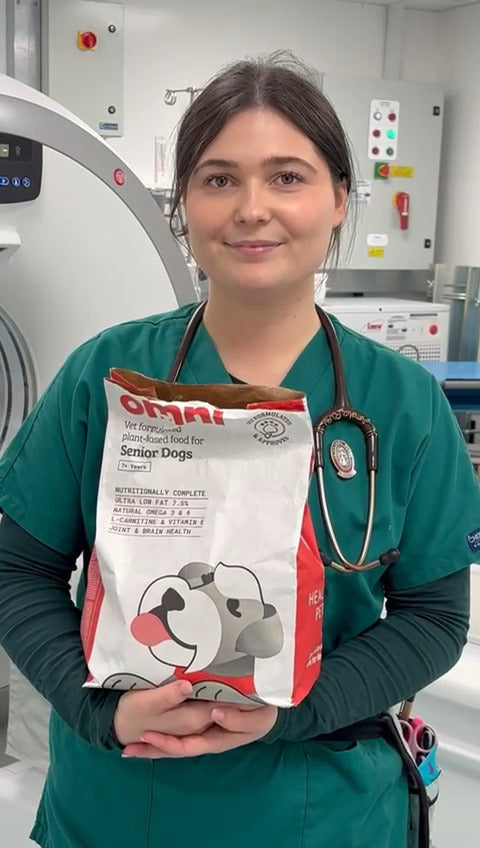Omni vs. Bonza: A Comparison of Leading Novel Protein Dog Food Brands

As people are becoming ever more health conscious - especially as far as their pets are concerned - they are increasingly seeking out novel protein alternatives to traditional dog food to solve skin, gut and weight issues in particular.
Of special interest to most of these pet guardians is that they are not short-changing their dog on nutritional value, as well as not compromising on animal welfare or sustainability where possible.
Emerging from this shift in consumer tastes are two industry-leading brands – Omni and Bonza.
Both brands offer nutritionally complete dog foods, but there are a few key differences in their offerings, formulation, and company ethos that set them apart. In this article, we’ll tease apart exactly what those differences are.
Protein levels in Omni and Bonza Complete foods?
Both Omni and Bonza are novel protein dog foods, using ingredients like plants, yeasts and pulses to provide the necessary nutrients our dogs need, instead of conventional (and highly allergenic) animal proteins like chicken, turkey, and beef.
Bonza’s recipe contains 25% protein, just 7% above legal minimum as set out by FEDIAF (the European regulatory body for pet food) versus 30% in Omni’s recipe.
Although protein is an expensive component of pet food, Omni justifies a higher inclusion level on the basis that protein is the most important nutrient for dogs to thrive and that reduced bioavailability of some plant proteins in dogs means extra is needed to ensure minimum physiological requirements are both met and surpassed.
How Do Omni and Bonza’s Amino Acid Profiles Compare?
Not all proteins are created equal. Typically, the levels of different amino acids (the building blocks of a protein) will vary depending on the source, with egg protein widely being considered one of the most ‘complete’ amino acid profile of all protein sources.
For example, many plant proteins tend to be lower in certain amino acids and higher in others.
This means that, while a food may technically contain enough protein by overall percentage, the type of protein may not be providing the correct building blocks that dogs need for essential bodily functions.
This is especially true for sulphur-containing amino acids like methionine, which are often low in plant proteins.
Whereas many brands like Bonza use 1 or 2 hero (typically leguminous) proteins in their recipes, Omni intentionally uses 5 different sources of protein in its recipes to overcome the risk and to ensure the balance of amino acids is equivalent to meat.
This is particularly important as a lack of sulphur-containing amino acids like methionine can easily go unnoticed and over time could increase the risk of canine heart disease.
Do Omni or Bonza Have Life-Stage Specific Diets?
Being a health first company, Omni knows scientifically that optimal health outcomes arise when recipes are formulated for specific ages and stages in a dog’s life - from puppyhood through to seniority - rather than a ‘one size fits all’ approach.
For example, puppies need a recipe that will support their ongoing growth and brain development with higher protein and fat content, while senior dogs need a lower protein and fat content to support healthy weight and kidney function, as well as needing more L-carnitine for heart health and vitamin E to ward off free radicals and disease.
Bonza only offers one diet type for adult dogs, there are no recipes specifically made for the growth needs of puppies or for senior dogs aged 7 years and upwards.
Do Omni or Bonza Offer Hypoallergenic Recipes?
In addition to unique formulations for dogs of different ages and stages, Omni offers a unique hypoallergenic recipe – Omni Sensitivity – which, like Bonza’s recipe, is free of soya, grain, wheat, and gluten.
Omni Sensitivity is also richer in herbs and has a smaller, softer texture, making it more suitable for dogs suffering from texture- or taste-based fussiness, or those who require a food easier to chew.
Both Omni and Bonza use herbs and botanical extracts where possible; Bonza also supplements using synthetic versions of important nutrients like Omega-3 and 6, while Omni sources them from natural ingredients such as marine algae.
What Scientific Backing Do Omni and Bonza Have?
If science is of importance to your dog, you should know that out of all the novel protein and plant-based brands in the UK, Omni is the only one that has peer-reviewed science backing to show tangible health benefits in dogs eating the food for over a period of 3-12 months.
From this, we know that 90% of Omni customers observed an improvement in their dog’s stool consistency, 52% noticed improvement in skin and ear itchiness (which often results from food allergies), and 44% saw improvement in anxiety-related behaviours. Bonza has no such peer reviewed studies published.
How Nutritionally Complete Are Omni and Bonza?
Omni’s unique partnership with the University of Nottingham’s Veterinary School allows for post-nutritional analysis, to ensure that the nutrients the recipes are formulated to deliver are actually all present.
Like most other brands, Bonza does not appear to take this extra step and instead relies on software that predicts the nutrient levels of the finished product based on the ingredients being included.
The risk of nutrient deficiencies or toxic surpluses are arguably higher in foods that are not tested for post production nutritional analysis.
How Much Veterinary Expertise Do Omni or Bonza Have?
One of the most notable distinctions between Omni and Bonza is Omni's veterinary backing. Omni was founded by vets and has a team of five veterinary experts who are available to provide free consultations for their customers and are well versed in novel protein pet nutrition.
Bonza also offers contact with veterinary professionals but this is outsourced through an external provider, VidiVet, who does not specialise in vegan dog food, but rather provides a general vet consultation service to a variety of pet companies, including those selling raw meat.
Do Omni or Bonza Offer Personalised Subscription Services?
Both Omni and Bonza offer subscription services. Omni's newly-revamped Flexible Plan model gives customers the freedom to pause, skip, edit, or even gift orders as needed. Bonza offers a personalised meal plan based on your dog's specific needs, ensuring the right amount of food is delivered on time.
How Sustainable Are Omni and Bonza?
As leading plant-based dog food brands, both Omni and Bonza both take sustainability seriously. Omni goes the extra mile with its tree-planting initiative, now responsible for planting over 15,000 native trees around the world in what we term “the Omni forest”!
Omni also boasts a partnership with Battersea Dogs and Cats Home, actively supporting rescue centres with donations.
Since its launch, Omni saved an estimated 51,000 animals from the food chain between 2021 and 2023, and reduced the carbon footprint of dogs on an Omni diet by 73% compared to conventional meat-based foods.
Bonza is also committed to sustainability, partnering with organisations like 1% for the Planet, Trees for the Future, and The Rainforest Trust!
How Much Does Plant-Based Dog Food Cost with Omni or Bonza?
Let’s look at Omni’s Adult Dog Food and Bonza’s default recipe.
A 10kg bag of Omni’s Adult Dog Food costs £65.99 if you buy it one-time only.
A similar bag of Bonza’s food costs £77 if you buy it one-time only.
On subscription, Omni will cost you just £52.79 for your first order, while Bonza would be £69.
On a per-kilogram basis, this means Omni is around 15-25% cheaper than Bonza, despite Omni’s extensive scientific backing.
How Do Omni and Bonza’s Customer Service Compare?
Both Bonza and Omni offer 9-5pm Monday-Friday customer service telephone service.
In addition, Omni boasts a 24/7 email support service, including free veterinary consultation, to include evenings and weekends.
What Does the Future Look Like?
For the range of products available, Omni is second-to-none in the novel proteins space, and the range is only just getting started. It currently includes nutritionally complete wet food, dry food, toppers, treats and, as of 2024, a newly-launched and successful range of plant-based supplements.
These supplements include formulations for joint health, stress & anxiety, anal glands, and fresh breath as the best-sellers, though there are even unique, vet-formulated, and science-backed supplements for doggy dementia and bladder problems, too!
Bonza, while providing an excellent all-round formulation, doesn’t yet offer these levels of targeted products or supplements outside of their core dog food recipe.
Summary
Both Omni and Bonza offer high-quality plant-based dog foods, but Omni stands out in several critical areas:
- Vet-founded and vet-formulated with peer-reviewed recipes, providing superior scientific validation.
- Age-specific dietary formulations and a popular range of plant-based supplements.
- Proven nutritional completeness, surpassing FEDIAF guidelines, with proven health outcomes.
- A more affordable & accessible product for those who don’t want saving the Earth to cost the Earth!
Bonza is a solid choice for people looking to try out a plant-based diet for their dogs, but for pet guardians who prioritise veterinary expertise, scientific backing, and affordability, Omni remains the leading option in the UK’s plant-based pet food market.
Omni is not just a brand; Omni is the champion of novel protein pet nutrition, backed by science, sustainability, and a love for dogs everywhere.






 85 Great Portland Street, 1st Floor, London, W1W 7LT United Kingdom
85 Great Portland Street, 1st Floor, London, W1W 7LT United Kingdom